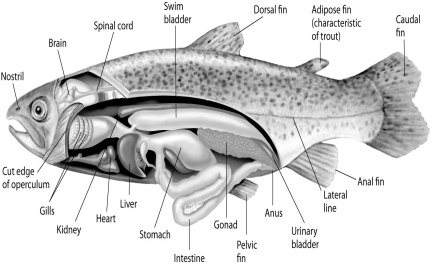Multiple Choice

Figure 34.1
Fishes that have swim bladders can regulate their density and, thus, their buoyancy. There are two types of swim bladder: physostomus and physoclistus. The ancestral version is the physostomus version, in which the swim bladder is connected to the esophagus via a short tube (Figure 34.1) . The fish fills this version by swimming to the surface, taking gulps of air, and directing them into the swim bladder. Air is removed from this version by "belching." The physoclistus version is more derived, and has lost its connection to the esophagus. Instead, gas enters and leaves the swim bladder via special circulatory mechanisms within the wall of the swim bladder.
-The presence of a swim bladder allows the typical ray-finned fish to stop swimming and still
A) effectively circulate its blood.
B) be highly maneuverable.
C) use its lateral line system.
D) use its swim bladder as a respiratory organ.
E) not sink.
Correct Answer:

Verified
Correct Answer:
Verified
Q23: A new species of aquatic chordate is
Q88: Which of the following are the only
Q89: The following questions refer to the description
Q90: Which of the following are the most
Q91: The oldest fossil remains of Homo sapiens
Q92: In order for the four-chambered hearts of
Q94: Arrange the following taxonomic terms from most
Q95: Which of the following are considered apes?<br>A)
Q96: The feeding mode of the extinct conodonts
Q98: Some bird bones are hollow rather than